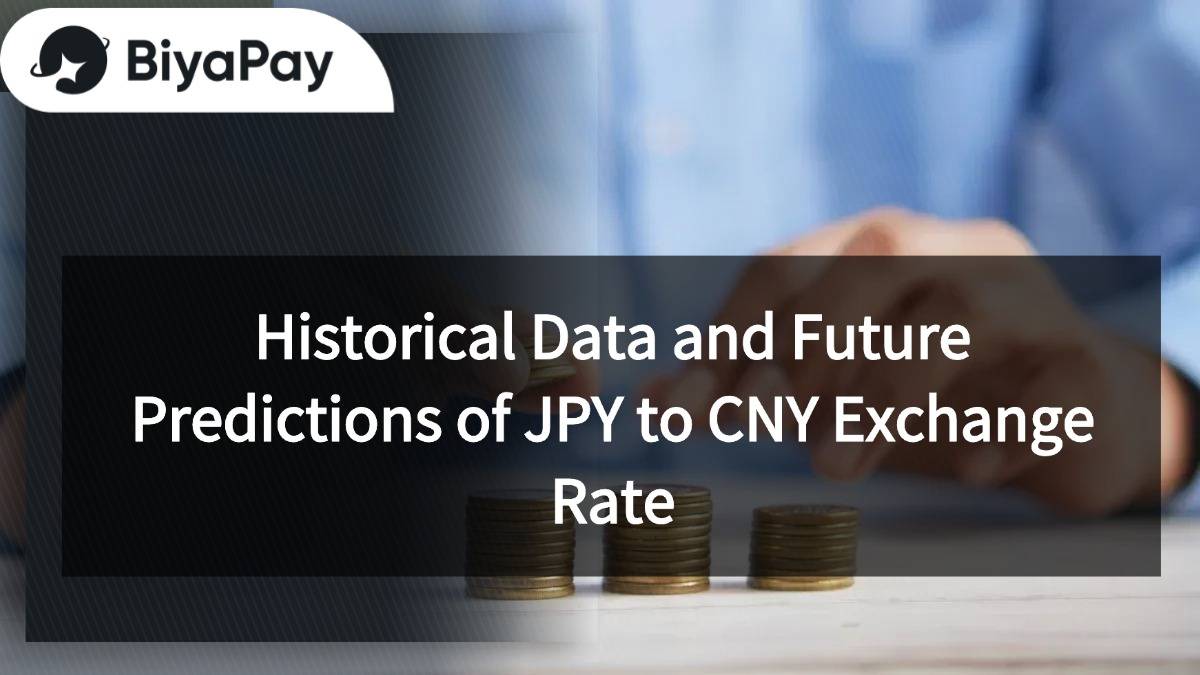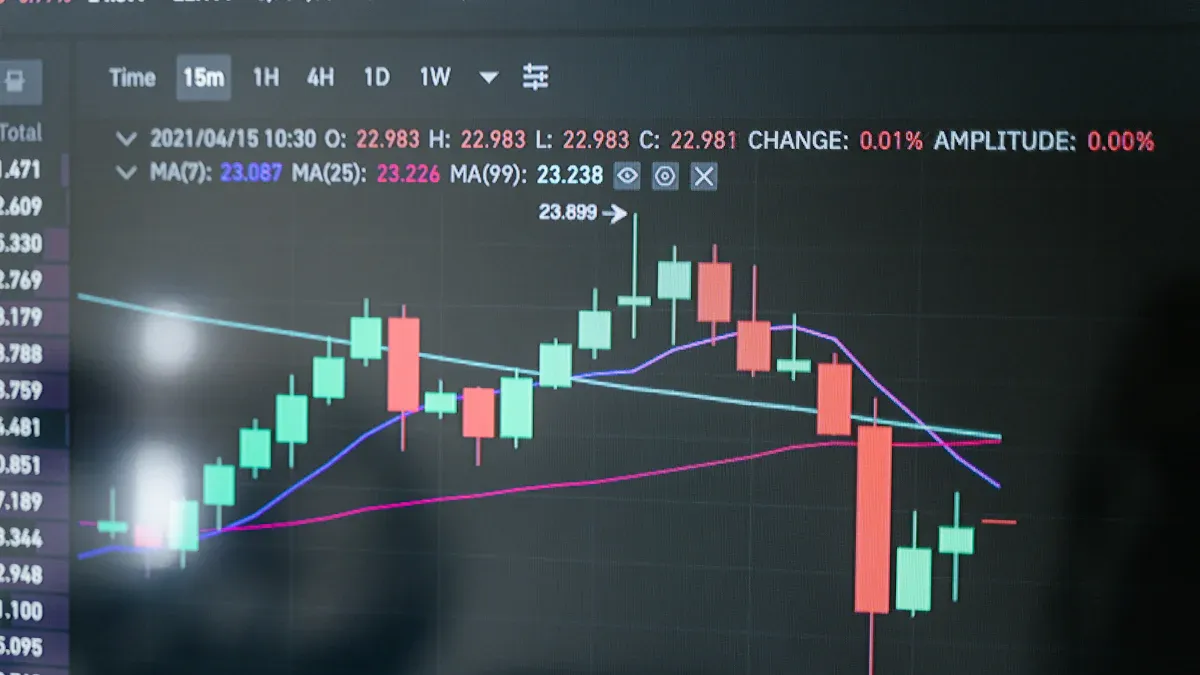- EasyCard
- Trade
- Help
- Announcement
- Academy
- SWIFT Code
- Iban Number
- Referral
- Customer Service
- Blog
- Creator
Historical Data and Future Predictions of JPY to CNY Exchange Rate

Image Source: pexels
The latest exchange rate data for JPY to CNY comes from Investing.com, a platform renowned for providing real-time exchange rates, historical data, and technical analysis, with data sources widely recognized as authoritative. According to the latest statistics, the JPY to CNY exchange rate exhibits volatility consistent with historical trends. This fluctuation is particularly significant in the context of economic conditions.
Exchange rate fluctuations have profound impacts on individuals and businesses. For individuals, the cost of JPY to CNY remittances may vary with exchange rate changes, affecting budgets for study abroad, travel, and cross-border shopping. Businesses engaged in international trade also face profit risks and cost variations due to exchange rate fluctuations. Therefore, monitoring exchange rate dynamics helps in better formulating financial plans and transaction strategies.
Latest Status of JPY to CNY Exchange Rate
Current Exchange Rate Data and Its Sources
JPY to CNY exchange rate data comes from various sources, but authority and accuracy are key criteria for selecting a data platform. Below are some representative exchange rate data sources:
- Hesi Travel Online Management System uses authoritative forex data sources to ensure data accuracy and timeliness.
- Investing.com provides real-time exchange rates and historical data, widely recognized by financial market participants.
- Exchange rate information published by financial institutions such as Hong Kong banks is highly credible due to their direct involvement in forex transactions.
These data sources provide reliable references for individuals and businesses, helping them make informed decisions in JPY to CNY remittances and other forex transactions.
Market Background and Significance of JPY to CNY Remittances
In recent years, the market demand for JPY to CNY remittances has continued to grow, supported by various economic factors:
- Since the beginning of this year, the CNY spot exchange rate against the USD has depreciated slightly by 0.3%, while the JPY has depreciated by 5.9% against the USD. These exchange rate changes have affected the conversion costs between JPY and CNY.
- In the first half of this year, China’s current account surplus reached 93.7 billion USD, accounting for 1.1% of GDP. The surplus remained at a reasonable level in the third quarter, demonstrating the stability of the Chinese economy.
- In 2021, the total amount of cross-border CNY receipts and payments handled by banks on behalf of clients reached 36.6 trillion yuan, a year-on-year increase of 29.0%. The share of CNY in international payments also rose to 3.2% in January 2022.
Market transaction data further reflects the activity level of JPY to CNY remittances:
- In 2018, the total amount of cross-border trade CNY settlement business was 5.1 trillion yuan, indicating the increasing use of CNY in international trade.
- In the same year, the CNY settlement amount for direct investment reached 2.66 trillion yuan, reflecting growing investor confidence in the CNY.
- Over 349,000 enterprises participated in CNY cross-border business, indicating increasing market activity.
The significance of JPY to CNY remittances extends beyond the individual level, profoundly impacting businesses’ international trade and investment decisions. By rationally planning remittance timing and amounts, individuals and businesses can effectively reduce risks posed by exchange rate fluctuations.
Historical Data Analysis of JPY to CNY Exchange Rate

Image Source: pexels
Key Time Points of Exchange Rate Changes Over the Past Decade
Over the past decade, the JPY to CNY exchange rate has experienced several significant fluctuations. Below are some key time points and their corresponding exchange rate changes:
| Phase | Time Range | Exchange Rate Change |
|---|---|---|
| Phase 1 | January to End of July | Rose from 7.10 to 7.28 |
| Phase 2 | August to September | Appreciated from 7.28 to 7.01 |
| Phase 3 | October to Year-End | Rebounded from 7.01 to 7.27 |
These data indicate that exchange rate fluctuations are often closely tied to specific economic events or policy adjustments. Understanding these time points helps analyze the reasons for exchange rate changes and provides a reference for future JPY to CNY remittances.
Main Trends in Historical Data
From historical data, the changes in the JPY to CNY exchange rate exhibit the following main trends:
- International Balance of Payments: When Japan records a current account surplus, the JPY typically appreciates; a deficit leads to depreciation.
- Unemployment Rate: Changes in the unemployment rate reflect the health of the macroeconomy, thereby affecting the exchange rate.
- Gross Domestic Product (GDP): GDP growth typically enhances currency value, driving exchange rate increases.
- Consumer Price Index (CPI): Changes in CPI reflect inflation levels, directly impacting currency purchasing power and exchange rates.
These trends indicate that fundamental economic indicators have a significant impact on the long-term trend of exchange rates.
Impact of Major Economic Events on Exchange Rates
Certain major economic events have significantly influenced the JPY to CNY exchange rate. For example:
| Economic Temperature Change | Real Effective Exchange Rate Depreciation |
|---|---|
| 0.19°C Higher Than Other Economies | 5.75% to 6.01% |
| Average Temperature Exceeding 14°C or 15°C | Tends to Depreciate |
Additionally, climate risks have indirectly affected exchange rates:
| Climate Risk Type | Impact on Net External Assets |
|---|---|
| Physical Climate Risk | U-shaped Impact |
| Transition Climate Risk | U-shaped Impact |
These data suggest that global climate change and economic policy adjustments may influence exchange rate fluctuations through complex mechanisms. Businesses and individuals should closely monitor these factors when conducting JPY to CNY remittances to better manage exchange rate risks.
Main Factors Affecting the JPY to CNY Exchange Rate
Economic Policies of Japan and China
The economic policies of Japan and China directly affect the JPY to CNY exchange rate. The two countries differ significantly in their stages of economic development and policy objectives. Below is a comparison of economic policy data:
| Indicator | China Per Capita GDP (2006) | Japan Per Capita GDP (2006) | Gap |
|---|---|---|---|
| PPP Estimate | 8,004 International Dollars | 31,866 International Dollars | Approximately 4 times that of China |
| Exchange Rate Estimate | 2,040 USD | 34,955 USD | China is only 5.8% of Japan |
China has enhanced its economic competitiveness in recent years through industrialization and economic internationalization. The core of industrialization lies in the increasing share of the secondary industry’s output, while Japan focuses more on the development of the tertiary industry. These structural differences lead to varying focuses in monetary policies. For example, the Bank of Japan has long implemented low-interest-rate policies to stimulate the economy, while China regulates economic growth through flexible monetary policies.
Additionally, a comparison of China’s economic internationalization level with global averages and other countries shows that China’s position in the global economy is steadily rising. This trend has positively contributed to the internationalization and stability of the CNY.
International Trade and Geopolitical Factors
International trade and geopolitical factors significantly influence the JPY to CNY exchange rate. Trade surpluses or deficits directly affect currency demand. For example, when Japan’s exports to China increase, demand for JPY rises, potentially leading to JPY appreciation, and vice versa.
Geopolitical events can also trigger exchange rate fluctuations. For instance, regional conflicts or international sanctions may heighten investor risk aversion, driving JPY appreciation. China’s Belt and Road Initiative, by strengthening economic cooperation with other countries, indirectly stabilizes the CNY’s international position.
Market Sentiment and Investor Behavior
Market sentiment and investor behavior are important short-term factors affecting exchange rates. Below are some key indicators:
| Indicator | Description |
|---|---|
| Sentiment Trend Index | Reflects the cyclical state and volatility of market sentiment |
| Volatility Index | Assists in assessing market stages and risk concentration |
| Transaction Sentiment Volatility | Effectively reflects market risk expectations |
Sentiment quantification models convert market sentiment and confidence levels into numerical values, helping investors assess market risks and opportunities more scientifically. For example, when the market sentiment index rises, investors may be more inclined to buy safe-haven assets like the JPY, driving its appreciation. By analyzing these data, individuals and businesses can more accurately judge market trends and optimize the timing of JPY to CNY remittances.
Changes in market sentiment are often sudden. Investors should closely monitor relevant indicators to adjust strategies promptly amid market fluctuations.
Future Trend Predictions for JPY to CNY Exchange Rate

Image Source: pexels
Expert Views on Future Exchange Rates
Experts generally believe that the JPY to CNY exchange rate will be influenced by multiple economic factors in the coming years. Below are some key prediction data:
| Indicator | Value |
|---|---|
| Fiscal Deficit as a Percentage of GDP | 2025: 4.0% (2024: 3.0%) |
| Special Sovereign Bond Quota | 2025: 2 trillion CNY |
| Local Government Special Bond Quota | 2025: 4.5-5 trillion CNY |
| Policy Interest Rate Change | Expected reduction of 40 basis points |
| USD to CNY Exchange Rate Expectation | Expected to reach 7.5 |
These data indicate that China’s fiscal policy will remain accommodative to support economic growth. Meanwhile, the rise in the USD to CNY exchange rate may indirectly affect the JPY to CNY exchange rate. Experts predict that the JPY to CNY exchange rate may maintain a certain level of volatility in the coming years, with the overall trend depending on the economic policy adjustments of both countries.
Technical Analysis and Data Model Predictions
Technical analysis provides a more scientific reference for future exchange rate predictions through data models. Below are the prediction results of some key models:
- Using the ARMA (1, 2) model to fit the first 900 data points, the prediction interval for the subsequent 100 data points has a 95% confidence level.
- Most actual values fall within the ARMA model’s prediction interval, validating the model’s effectiveness.
- Another model’s prediction results show that all actual values fall within the confidence interval, indicating good overall prediction performance.
- Only 4 actual values fall outside the confidence interval, demonstrating the effectiveness of the model combination.
These technical analysis results show that, despite some uncertainty in exchange rate predictions, scientific models can effectively reduce error ranges. Investors and businesses can use these prediction results to optimize the timing and amount of JPY to CNY remittances, reducing risks from exchange rate fluctuations.
Strategies for JPY to CNY Remittances
Facing the uncertainty of future exchange rates, individuals and businesses can adopt the following strategies to cope:
- Split Remittances: Divide large remittances into multiple smaller transactions to spread the risk of exchange rate fluctuations.
- Monitor Market Dynamics: Regularly track exchange rate changes and economic policy adjustments to choose favorable rate timings for remittances.
- Use Financial Tools: Lock in exchange rates through forward forex contracts or options to reduce future uncertainty.
- Consult Professional Institutions: Seek professional advice from banks or forex trading platforms to develop more scientific remittance plans.
Through these strategies, individuals and businesses can better address the challenges of exchange rate fluctuations, especially when conducting JPY to CNY remittances, where rational planning of remittance timing and amounts is particularly important.
Conclusion
Historical data on the JPY to CNY exchange rate reveals its volatility and close connection to economic events. Future trend predictions indicate that exchange rate changes will continue to be influenced by multiple factors, including economic policies, international trade, and market sentiment. Businesses and individuals must pay close attention to these changes when making decisions.
The importance of exchange rate fluctuations for decision-making lies in their direct impact on costs and returns. The following statistical data further illustrate this point:
| Statistical Analysis Result | Impact Level | Correlation |
|---|---|---|
| CNY and JPY Exchange Rate Changes | Certain Degree | Positive Correlation |
To better address exchange rate changes, it is recommended to monitor market dynamics and rationally plan forex transactions. Strategies such as split remittances and using financial tools can effectively reduce risks. Through scientific decision-making, individuals and businesses can achieve greater financial stability in complex exchange rate environments.
FAQ
1. How Frequent Are JPY to CNY Exchange Rate Fluctuations?
The frequency of JPY to CNY exchange rate fluctuations depends on market factors. Typically, the exchange rate experiences slight daily changes, especially during active international market trading. Investors should monitor real-time data to adjust decisions promptly.
2. Which Platforms Can Provide the Latest Exchange Rates?
The following platforms offer authoritative exchange rate data:
- Investing.com: Real-time updates, suitable for professional investors.
- Bank Websites: Such as Bank of China and China Merchants Bank.
- Forex Trading Platforms: Such as OANDA.
Tip: Choose reliable platforms to ensure data accuracy.
3. How Do Exchange Rate Fluctuations Affect Students?
Exchange rate fluctuations directly impact the conversion costs of tuition and living expenses. For example, when the JPY depreciates, students’ costs for converting to CNY decrease. It’s recommended that students split forex conversions to reduce risks.
4. How to Reduce Risks from Exchange Rate Fluctuations?
The following strategies can effectively reduce risks:
- Use forward forex contracts to lock in exchange rates.
- Split forex conversions to avoid single large transactions.
- Regularly monitor market dynamics to choose favorable timings.
5. Will the JPY to CNY Exchange Rate Stabilize in the Future?
Future exchange rate stability depends on multiple factors, including economic policies, international trade, and market sentiment. Experts predict short-term volatility may persist, but long-term trends require analysis of economic fundamentals.
Note: Investors should adjust strategies based on the latest data to avoid blind decisions.
Fluctuations in the JPY/CNY exchange rate pose challenges for businesses and individuals managing remittance costs and currency risks. BiyaPay delivers a cost-effective, streamlined solution! Exchange over 30 fiat currencies and 200+ cryptocurrencies with transparent real-time rates, and benefit from transfer fees as low as 0.5% across 190+ countries, with same-day initiated, same-day delivered transfers. Sign up for BiyaPay in just one minute to access seamless JPY-to-CNY remittances and US/HK stock investments without complex account setups. Plus, grow idle funds with a 5.48% annualized yield on flexible savings. Secured by U.S. MSB and SEC licenses and blockchain technology, BiyaPay ensures trust and safety. Start now—join BiyaPay to lock in low-cost transfers, mitigate exchange rate risks, and unlock efficient global financial opportunities!
*This article is provided for general information purposes and does not constitute legal, tax or other professional advice from BiyaPay or its subsidiaries and its affiliates, and it is not intended as a substitute for obtaining advice from a financial advisor or any other professional.
We make no representations, warranties or warranties, express or implied, as to the accuracy, completeness or timeliness of the contents of this publication.




Contact Us
Company and Team
BiyaPay Products
Customer Services
is a broker-dealer registered with the U.S. Securities and Exchange Commission (SEC) (No.: 802-127417), member of the Financial Industry Regulatory Authority (FINRA) (CRD: 325027), member of the Securities Investor Protection Corporation (SIPC), and regulated by FINRA and SEC.
registered with the US Financial Crimes Enforcement Network (FinCEN), as a Money Services Business (MSB), registration number: 31000218637349, and regulated by FinCEN.
registered as Financial Service Provider (FSP number: FSP1007221) in New Zealand, and is a member of the Financial Dispute Resolution Scheme, a New Zealand independent dispute resolution service provider.




















